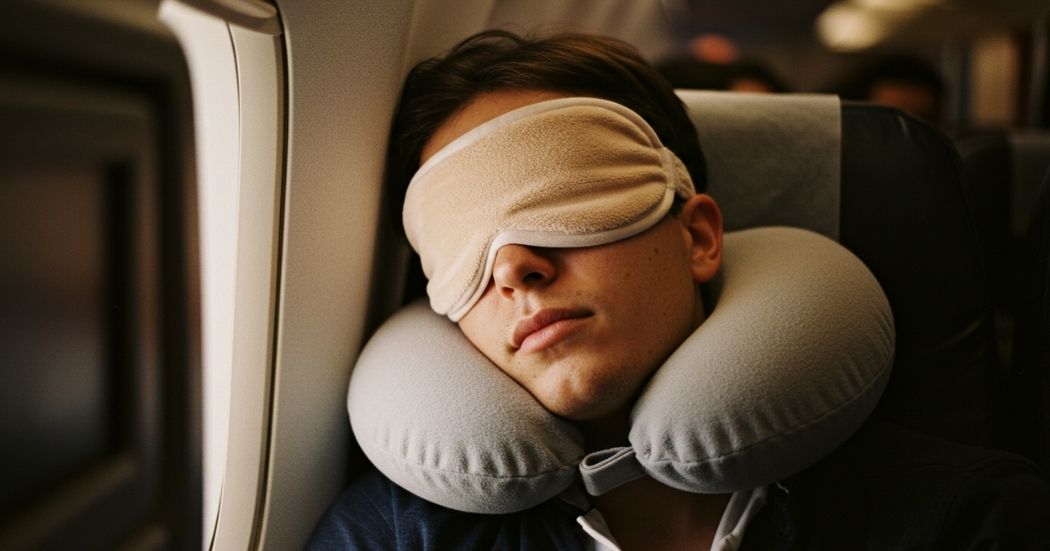Crossing multiple time zones can leave you feeling like your brain stayed several thousand miles behind. That profound sense of disorientation, fatigue, and mental fog isn’t just an inconvenience; it’s jet lag, a significant disruption to your body’s delicate internal clock, known as your circadian rhythm.
Jet lag impacts far more than just your mood:
- Sleep Quality: It directly interferes with your ability to fall asleep and stay asleep at the correct local time, leading to fragmented and non-restorative rest.
- Hormone Balance: It throws off the natural production cycles of crucial hormones like melatonin (for sleep) and cortisol (for alertness and stress response).
- Energy and Focus: You experience debilitating daytime fatigue, profound brain fog, and difficulty concentrating.
- Mood Regulation: Irritability, anxiety, and even low mood are common symptoms as your body struggles to adapt.
- Digestive Issues: Your gut rhythm also gets disrupted, leading to potential stomach discomfort.
But here’s the good news: with the right sleep recovery strategies and a bit of proactive planning, you can significantly mitigate jet lag’s effects. You can reset your internal clock more efficiently, sleep deeper, and make the most of your trip, feeling energized rather than exhausted.

✈️ What Is Jet Lag, Really? Understanding the Circadian Disruption
At its core, jet lag (clinically known as desynchronosis) is a temporary sleep disorder caused by traveling rapidly across multiple time zones. Your body’s internal clock, regulated by light cues and genetic predispositions, struggles to align with the new local time. This misalignment creates a conflict between your body’s natural sleep-wake cycle and the demands of your new environment.
The common symptoms of jet lag arise directly from this internal struggle:
- Trouble falling asleep or waking up: Your body is still signaling sleep when it’s daytime, or vice versa.
- Persistent daytime fatigue: Despite hours in bed, you feel profoundly tired and drained.
- Brain fog and irritability: Cognitive functions are impaired, and your mood can swing dramatically.
- Digestive issues: Your appetite and digestion may be out of sync, leading to discomfort.
- Reduced physical performance: Athletes often notice a dip in strength, endurance, and coordination.
It’s worth noting that eastward travel (e.g., flying from New York to Paris) typically causes more severe jet lag than westward travel. This is because flying east shortens your perceived day, requiring your body to advance its clock, which is biologically harder than delaying it (as happens with westward travel that lengthens your day).
🧭 7 Proven Sleep Recovery Strategies for Savvy Travelers
Don’t leave your sleep recovery to chance. These evidence-based strategies will help you adapt faster and feel better, ensuring your travel is about exploration, not exhaustion.
1. Shift Your Schedule Before You Fly: Pre-Adjust for a Smoother Landing
Proactive adjustment can dramatically reduce the severity of jet lag. Start preparing your body’s clock before you even leave home.
- Start Gradual Adjustments: Begin shifting your bedtime and wake time by 15–30 minutes per day for 2–3 days before departure.
- Eastward Travel (Shortening Your Day): Move your bedtime and wake time earlier each day. For example, if you’re crossing 6 time zones, try shifting by 1 hour each day for 6 days.
- Westward Travel (Lengthening Your Day): Delay your bedtime and wake time later each day. This is generally easier for the body to adapt to.
- Simulate Meals: If possible, try to eat meals closer to the times they will be served at your destination. Food intake can also act as a powerful time cue for your internal clock.
2. Leverage Light to Reset Your Clock: Your Circadian Control Panel
Light is the most potent external cue for regulating your circadian rhythm. Use it strategically in your new time zone to signal wakefulness or sleep.
- Embrace Morning Light: As soon as you wake up in the new time zone, seek out bright morning light. Step outside, open curtains, or even use a light therapy lamp. This strong light signal tells your brain: “It’s morning here, wake up!”
- Avoid Evening Light (Strategically): Conversely, avoid bright light exposure in the hours leading up to your new target bedtime, especially the blue light emitted from screens. This signals “nighttime” to your brain, allowing natural melatonin production.
- Block Unwanted Light: Carry dark sunglasses to wear if you arrive during your destination’s daytime but it’s still “night” for your body. For sleep, use a comfortable sleep mask (ideally silk or weighted) and ensure your hotel room is as dark as possible with blackout curtains. If you must use screens, wear amber- or red-tinted blue-light blocking glasses.
Tip: Tools like Jet Lag Rooster (https://www.jetlagrooster.com) can generate a personalized light exposure and sleep schedule based on your flight details, significantly simplifying this complex process.
3. Time Your Melatonin Wisely: A Circadian Rhythm Adjuster, Not a Sedative
Melatonin can be a useful tool for jet lag, but its effectiveness depends heavily on precise timing and dosage. Remember, it’s a circadian rhythm adjuster, not a sleeping pill.
- Optimal Dosage and Timing: Take a very low dose of melatonin (typically 0.3mg to 3mg) 30–60 minutes before your new target bedtime in the destination time zone.
- Best Use Cases: Melatonin is generally most effective for eastward travel (where you need to shift your clock earlier) or when crossing more than 3 time zones.
- Crucial Caution: Avoid taking melatonin at the wrong time (e.g., during your new destination’s daytime hours) as this can further confuse your circadian rhythm and actually worsen jet lag. Consult a healthcare professional if unsure.
4. Hydrate, Hydrate, Hydrate: Combatting Dehydration’s Drain
Airplane cabins are notoriously dehydrating environments. Dehydration exacerbates fatigue, headaches, and other jet lag symptoms.
- Avoid Dehydrators: Steer clear of alcohol and excessive caffeine during your flight. While tempting, these can further dehydrate you and disrupt sleep.
- Consistent Water Intake: Sip water frequently and consistently throughout your flight and during your entire trip. Aim to drink more than you typically would. Consider electrolyte mixes to replenish essential minerals.
5. Naps: Short and Strategic, Not Sabotaging
Naps can be a lifeline for battling daytime fatigue, but use them intelligently to avoid disrupting your nighttime sleep.
- Limit Duration: If you need to nap, keep it brief—ideally 20–30 minutes. This is often called a “power nap” and provides a refreshing boost without sending you into deep sleep stages, which can lead to grogginess upon waking and make it harder to sleep at night.
- Time it Right: Avoid long naps, especially after 3 PM local time in your new destination. Napping too late can significantly interfere with your body’s natural sleep drive when it’s actually bedtime.
- Reduce “Sleep Debt”: Use these strategic power naps to chip away at your accumulating “sleep debt” during the initial adjustment period.
6. Utilize Recovery Tools: Your Travel Sleep Kit
Pack smart with items designed to optimize rest in unfamiliar environments.
- Compression Socks: Wearing compression socks during long flights can help reduce swelling and improve circulation in your legs, minimizing overall travel fatigue.
- Sleep Mask and Neck Pillow: Essential for creating a dark, comfortable environment for rest on the plane, allowing for opportunistic sleep.
- White Noise or Earplugs: Hotels and Airbnb rentals can be surprisingly noisy. Pack a portable white noise machine or high-quality earplugs to block out disruptions and create a consistent soundscape for sleep.
- Wearable Sleep Trackers: Devices like the Oura Ring or Whoop can be incredibly valuable. They provide objective data on your sleep stages, HRV, and recovery status, giving you insights into how well you’re adapting to the new time zone and when your body genuinely needs more rest.
7. Embrace Gentle Movement and Smart Nutrition: Fueling Adaptation

Support your body’s adjustment with physical activity and thoughtful food choices.
- Move Regularly: During long flights, get up and walk around every few hours to improve circulation. Upon arrival, light physical activity like a short walk outdoors in the morning sun can help signal wakefulness and reinforce your new circadian rhythm. Avoid intense exercise too close to your new bedtime.
- Nutrient-Dense Foods: Focus on whole, unprocessed foods. Include sources of Magnesium Glycinate and Glycine (as discussed in previous articles) to help calm the nervous system and promote deeper sleep, especially in the evening.
- Avoid Energy-Spiking Meals: Steer clear of sugar-heavy airport meals or processed snacks. These can cause blood sugar spikes and crashes, exacerbating fatigue and making it harder to regulate your energy. Opt for balanced meals with protein, healthy fats, and complex carbohydrates.
🌍 Real-World Example: Alex’s Seamless Tokyo Recovery
Alex, a frequent international business traveler, used to dread his trips from Los Angeles (PST) to Tokyo (JST), a grueling 16-hour time difference. He’d typically suffer from severe jet lag for 4-5 days, crippling his productivity.
On his most recent trip, Alex proactively implemented these strategies:
- Pre-Adjustment: He started shifting his sleep schedule by 30 minutes earlier each day for 4 days before his flight.
- In-Flight: He wore blue-light blockers immediately after takeoff and used a comfortable sleep mask and neck pillow, attempting to sleep whenever it was “nighttime” in Tokyo. He strictly avoided coffee and alcohol, opting for water and herbal tea.
- Upon Arrival: He immediately adopted Tokyo local time. He used a very low dose of melatonin (0.5mg) about 45 minutes before his target 10 PM bedtime on the first two nights. Crucially, each morning, he went for a 15-minute brisk walk outdoors to maximize morning light exposure.
- Strategic Naps: If he felt an overwhelming urge to nap during the day, he limited it strictly to 20 minutes before 3 PM.
The result was astonishing: Alex experienced a significant sleep reset by day 3, feeling almost no “jet lag fog.” He was able to attend meetings, explore the city, and feel genuinely energized, transforming his usual exhausting trip into a productive and enjoyable experience.
Final Thoughts: Reprogram Your Body, Elevate Your Travel
Jet lag isn’t just about catching up on lost sleep; it’s about reprogramming your internal time zone to align with your new location. It requires a mindful, proactive approach that works with your body’s biology, rather than against it.
With the right tools, smart timing of light exposure, and consistent sleep recovery strategies, your body’s incredible adaptive capabilities can kick in quickly. This means your next adventure or business trip can feel energizing and productive, rather than an exhausting battle against your own clock. Take control of your circadian rhythm, and elevate your travel experience.
Is jet lag consistently ruining the start of your trips? Don’t let it drain your energy. Download our comprehensive Traveler’s Sleep Recovery Guide now to gain actionable strategies, beat fatigue, and reset faster—wherever your journey takes you. Plan smarter, travel better!
🌍 Ready to Beat Jet Lag and Travel Strong?
Smart circadian resets and recovery techniques don’t stop at travel. Level up your post-flight routine with these expert guides:
- → How to Build a Circadian Rhythm Reset That Lasts
- → 10 Proven Tips for Better Circadian Health and Energy
- → What If These Mindset Shift Habits Could Change How You Handle Fatigue?
🛫 You don’t just have to recover from travel—you can thrive through it. Reset smarter, sleep deeper, and travel farther.
📚 References
- Arendt, J. (2009). Managing jet lag: Some of the problems and possible new solutions. Sleep Medicine Reviews, 13(4), 249–256.
https://doi.org/10.1016/j.smrv.2008.07.011 - Sack, R. L., et al. (2007). Circadian rhythm sleep disorders: Jet lag and shift work. Sleep, 30(11), 1460–1483.
https://doi.org/10.1093/sleep/30.11.1460 - Waterhouse, J., et al. (2007). Jet lag: trends and coping strategies. The Lancet, 369(9567), 1117–1129.
https://doi.org/10.1016/S0140-6736(07)60529-7

